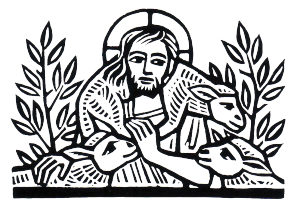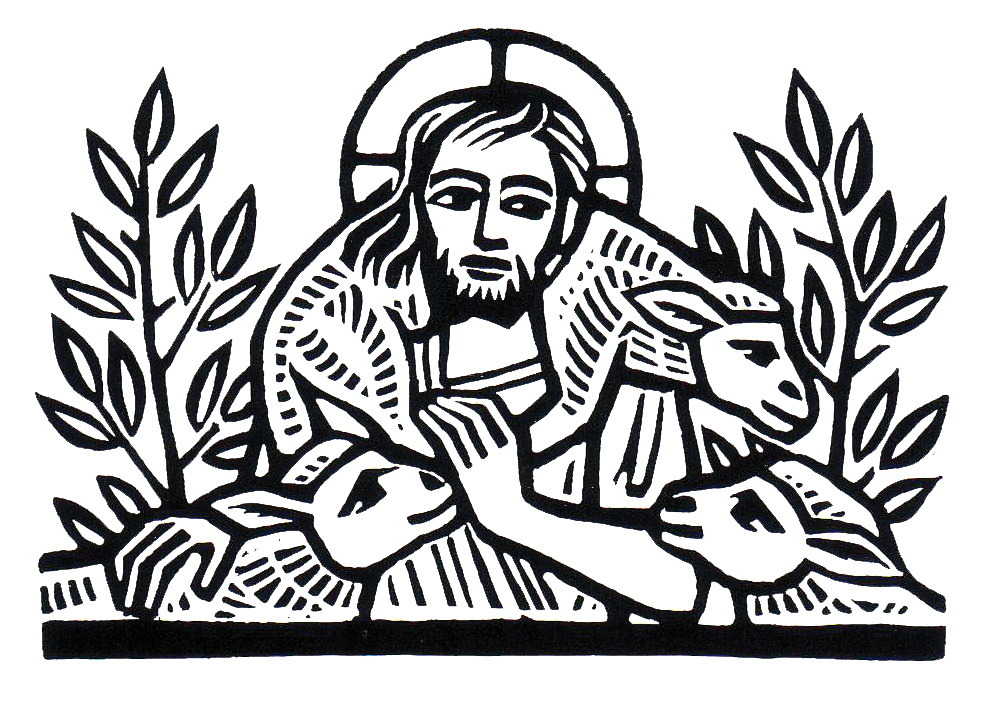
Central idea: Christ is the Good Shepherd. Doctrine: Priests as good shepherds. Practical application: Docility to our Good Shepherd and to our good shepherds.
To view Lectionary 51, click here.
Central idea: Christ is the Good Shepherd
Reading 1 Acts 13:14, 43-52
Paul and Barnabas continued on from Perga
and reached Antioch in Pisidia.
On the sabbath they entered the synagogue and took their seats.
Many Jews and worshipers who were converts to Judaism
followed Paul and Barnabas, who spoke to them
and urged them to remain faithful to the grace of God.On the following sabbath almost the whole city gathered
to hear the word of the Lord.
When the Jews saw the crowds, they were filled with jealousy
and with violent abuse contradicted what Paul said.
Both Paul and Barnabas spoke out boldly and said,
“It was necessary that the word of God be spoken to you first,
but since you reject it
and condemn yourselves as unworthy of eternal life,
we now turn to the Gentiles.
For so the Lord has commanded us,
I have made you a light to the Gentiles,
that you may be an instrument of salvation
to the ends of the earth.”The Gentiles were delighted when they heard this
and glorified the word of the Lord.
All who were destined for eternal life came to believe,
and the word of the Lord continued to spread
through the whole region.
The Jews, however, incited the women of prominence who were worshipers
and the leading men of the city,
stirred up a persecution against Paul and Barnabas,
and expelled them from their territory.
So they shook the dust from their feet in protest against them,
and went to Iconium.
The disciples were filled with joy and the Holy Spirit.
- Paul and Barnabas are shepherds seeking sheep who will hear the voice of the Good Shepherd and then follow him. In Antioch in Pisidia, Jews, converts to Judaism, righteous Gentiles, and then, evidently, even pagan Gentiles, heard their preaching and were attracted.
- This attractive message incited opposition, which is a perennial response.
- The first Christians, who were all Jews, were opposed by some Jewish authorities.
- Later, Christians were persecuted on and off during the next three hundred years in the Roman Empire.
- We had all better get ready to face persecution ourselves in the increasingly anti-Christian, anti-Catholic culture that surrounds us.
Responsorial Psalm Ps 100:1-2, 3, 5
R. We are his people, the sheep of his flock or Alleluia
Sing joyfully to the LORD, all you lands;
serve the LORD with gladness;
come before him with joyful song.Know that the LORD is God;
he made us, his we are;
his people, the flock he tends.The LORD is good:
his kindness endures forever,
and his faithfulness, to all generations.
- Despite some opposition to Christ and his Church from some Jews, the Chosen People still are God’s people, his flock. And we Christians are God’s New People, also his flock, redeemed by Christ the Good Shepherd.
- As St. Peter proclaimed, “In truth, I see that God shows no partiality. Rather, in every nation whoever fears him and acts uprightly is acceptable to him.” (Acts 10: 34-35) The Faith and those shepherds who carry it forward are a light to the nations.
- Despite the personal sacrifices a person has to make to follow the Lord, despite any persecutions we suffer from others, being one of God’s flock makes us very happy even now. “The Lord is good” and he is good to us.
- When Barnabas and Paul were expelled from Antioch, they “were filled with joy and the Holy Spirit.”
Reading 2 Rev 7:9, 14b-17
I, John, had a vision of a great multitude,
which no one could count,
from every nation, race, people, and tongue.
They stood before the throne and before the Lamb,
wearing white robes and holding palm branches in their hands.Then one of the elders said to me,
“These are the ones who have survived the time of great distress;
they have washed their robes
and made them white in the blood of the Lamb.“For this reason they stand before God’s throne
and worship him day and night in his temple.
The one who sits on the throne will shelter them.
They will not hunger or thirst anymore,
nor will the sun or any heat strike them.
For the Lamb who is in the center of the throne
will shepherd them
and lead them to springs of life-giving water,
and God will wipe away every tear from their eyes.”
- Are many saved? Yes, “a great multitude, which no one could count.”
- Are they just Jews? No. They are from “every nation, race, people, and tongue.”
- Why are they wearing white robes and holding palm branches? These are signs of victory.
- Our salvation and eternal life are presented through analogies. Jesus is both shepherd and lamb.
- He is the Good Shepherd who has saved his sheep: he has laid down his life for them.
- He is the Lamb of God who is sacrificed to save us from sin and death. He is like the Passover lamb: their shed blood delivered their people from death.
- The analogy also points out how much Christ, our Good Shepherd, identifies with his sheep. The shepherd has become a lamb himself. God has become man through the Incarnation of the Second Person of the Blessed Trinity.
- The Good Shepherd has done everything necessary to save his sheep. The sheep have also done something necessary to be saved, again presented by analogy: “They have washed their robes and made them white in the blood of the Lamb.”
- It takes some work to wash a robe. What is the work they did? They said yes to Christ and followed him and so “survived the time of great distress.”
- How much did this following cost them?
Alleluia Jn 10:14
I am the good shepherd, says the Lord;
I know my sheep, and mine know me.
Gospel Jn 10:27-30
Jesus said:
“My sheep hear my voice;
I know them, and they follow me.
I give them eternal life, and they shall never perish.
No one can take them out of my hand.
My Father, who has given them to me, is greater than all,
and no one can take them out of the Father’s hand.
The Father and I are one.”
- Don’t we want to be one of Jesus’ sheep? It means to have the fullness of life, securely, forever.
- If we are one of Jesus’ sheep, it is because we first belonged to the Father and he has given us to his Son.
- Are we one of Jesus’ sheep? Do we know what his voice even sounds like? Do we listen for it? Do we follow it? All this implies a personal relationship, which the Good Shepherd is eager to develop.
- My Father is greater than all. The Father and I are one. The Father, the Son, and the Holy Spirit are infinitely greater than all, because they are the One God. The three Persons are distinguished by their origin within the Godhead. The Father eternally begets the Son and the Holy Spirit eternally proceeds from the Father and the Son. The pasture the Good Shepherd leads us to is the inner life of the Blessed Trinity.
Doctrine: Priests as good shepherds
- Although Catholic priests are men like us, the priesthood itself is not a human institution. Christ created the office of Holy Orders so that some men could serve His church according to His own priesthood. (CCC 874)
- Priests “are appointed to nourish the Church with the word and grace of God in the name of Christ.”
- With the power of Christ they are the Good Shepherd for us in the Sacrament of Penance. (CCC 1119 & 1465)
- Priests “preach the Gospel and shepherd the faithful as well as . . . celebrate divine worship as true priests of the New Testament” (CCC 1564).
- The priest “by virtue of the sacrament of Holy Orders, acts in persona Christi Capitis,” that is, in the person of Christ the Head of the Church. Through the priest “it is Christ himself who is present to his Church as Head of his Body, Shepherd of his flock, high priest of the redemptive sacrifice, Teacher of Truth.” This is why the priest is a sacred person. (CCC 1548)
- The priest is also a man who can be weak and can sin. He has to struggle to be faithful to Christ and to the members of the Church entrusted to him (CCC 1550).
- The priesthood is ministerial, an office of service. In the exercise of his sacred authority, his model is Jesus Christ, “who by love made himself the least and the servant of all. ‘The Lord said clearly that concern for his flock was proof of love for him.’” (CCC 1551)
- From all this we can say that the minsterial priest has an exalted calling and a tremendous responsibility.
Practical application: Docility toward our Good Shepherd and good shepherds
- Docility is the virtue or good habit by which we are easily teachable and led.
- A docile person complies with the legitimate demands of legitimate authority.
- The docile person learns by observing, obeying, and imitating the person he is following.
- The docile person corrects himself when he is justly corrected.
- The docile person knows he is ignorant about many things and so is humble, recognizing he needs to learn.
- A docile person also needs to be prudent. Therefore, he maintains a legitimate doubt both about his own biases and toward ideas being presented to him which conflict with his fundamental values.
- From this consideration, it should be easy to see that since Christ is the Good Shepherd we should be docile toward him. We should obey his voice. We should learn from him and imitate him. We should accept his correction. We should always to open to learning new things from him. We should be as “wise as serpents and innocent as doves” (Mt 10:16).
- The same is true of his good shepherds, our Catholic priests, and of course, our diocesan bishop. For most of us, our good shepherd in human form is the pastor of our parish. As long as we are prudent, we should have no fear of following him whenever and to the extent that he is acting in the person of Christ under the authority of his bishop who is a successor of the apostles, good shepherds like Paul and Barnabas.
Written as an aid for homilists and a resource for the faithful, this doctrinal homily outline (1) provides insights into the Lectionary readings, (2) explicates a doctrine of Catholic Faith or morals from them, and (3) shows specific ways lay persons can live these truths. (To read more about this approach, click here.)
This outline is written to be in accord with the Homiletic Directory issued by the Congregation for Divine Worship and the Discipline of the Sacraments (2014). (To read an excellent summary of the Homiletic Directory, click here.)
Homiletic Directory offers the following Catechism points and themes for the Fourth Sunday of Easter:
- CCC 754, 764, 2665: Christ the Shepherd and Gate
- CCC 553, 857, 861, 881, 896, 1558, 1561, 1568, 1574: Pope and bishops as shepherds
- CCC 874, 1120, 1465, 1536, 1548-1551, 1564, 2179, 2686: priests as shepherds
- CCC 60, 442, 543, 674, 724, 755, 775, 781: the Church is made up of Jews and Gentiles
- CCC 957, 1138, 1173, 2473-2474: our communion with the martyrs

Leave a Reply